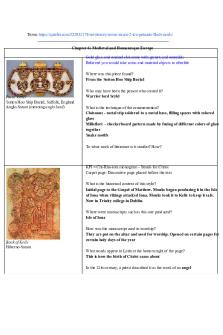Study Guide exam 2 PDF

| Title | Study Guide exam 2 |
|---|---|
| Course | General Psychology |
| Institution | San Francisco State University |
| Pages | 2 |
| File Size | 98.1 KB |
| File Type | |
| Total Downloads | 50 |
| Total Views | 134 |
Summary
Study guide exam 2...
Description
STUDY GUIDE
EXAM 2 OCTOBER 16; online 8am-12 noon; iLearn
As you study, try to generate examples of concepts and functioning or at least recall examples from lecture to help you understand. You may use one page, one side of handwritten notes to the test. Chapter 3 Biological Foundations -what is the difference between genotype vs phenotype -how do twin studies help establish heritability; what is the difference between heredity and heritability? -what is behavioral genetics? What is meant by the interaction of genetics and environment? -what are alleles; concept of dominant vs recessive -what is the structure and nature of the neuron: dendrite, axon, cell body, synapse, vesicles, myelin -what is the difference between afferent vs efferent neurons -what are the basics of action potential; all or nothing principle of neural activity; propagation of nerve impulse -what is the role of excitatory vs inhibitory neurotransmitters; agonist vs antagonists -what happens to neurotransmitters after their release? -know these neurotransmitters and the role they play: dopamine, seratonin, endorphine, GABA, acetylcholine -know the basic concepts of hemispheric specificity, spilt brain functioning (from the Pieces of Mind film with Alan Alda and Mike Gazzaniga) -what are the basic components of CNS: brain stem structures (tectum, reticular formation, pons, medulla) and cerebellum; limbic systems (amygdala, hippocampus, hypothalamus) and thalamus -what are the lobes of the cortex and their basic functioning -what are the general functional differences of the right and left hemisphere? Understand what the corpus callosum and what is meant by contralateral control -what have we learned from split brain functioning; purpose of severing corpus callosum -role of critical period and brain development; remapping of the cortex; the concept of plasticity. -deficit hypothesis for understanding functioning -techniques of imaging the brain -trepanning and lesioning -what are the components of PNS -what are the basics of hormone effects, e.g. how do hormones operate -what are the components of PNS Chapter 4 Consciousness -know the basic concepts of hemispheric specificity, spilt brain functioning -role of central executive functioning -how do we define consciousness? -automatic vs conscious processing -what is qualia? neural workspace? executive functioning?
-stages of sleep -importance of REM -types of dreaming; theories of the role of dreaming -why do we sleep? -effects of sleep deprivation -sleep disorders? -major classes of drug and their effects in the brain (interaction with receptors and neural transmitters)and on functioning? Chapter 5 Sensation and Perception -what is the difference between sensation and perception? -what are thresholds, jnd? -what is the difference in qualitative and quantitative perception? -top down vs bottom up processing -what is sensory adaptation and why does it occur? why? -in general, for each system, understand the stimulus, organ of reception, receptors, basic path to brain, cortical processing -what is meant by chemical senses? -olfactory processing; significance of direct limbic processing -what are the basic tastes? characteristics of taste buds -what is the role of genetics in sensory capacity? -what are the cutaneous (haptic) sensations? -how are pain signals carried? -understand gate control theory of pain -know the structures of the ear -pitch, timbre, loudness: what properties of sound relate to these concepts? How are these properties similar to vision? -what is a proximal vs distal stimulus? - know the basic structures of the eye especially retina: rods and cones -in what ways is color processed? -know the principles of visual depth perception both monocular (gestalt, pictorial cues) & binocular (e.g retinal disparity, convergence) -what does the Ames room show us about perception -what is the figure-ground principle of visual perception -hue, saturation, brightness: what properties of light relate to these concepts? -cortex region for vision? audition?
Brain Plasticity: -know the key points from Dr. Merzenich’s lecture
GET SOME SLEEP BEFORE THE TEST!!!...
Similar Free PDFs

Exam 2 Study Guide
- 32 Pages

Exam 2 Study Guide
- 5 Pages

Exam #2 Study Guide
- 4 Pages

Exam 2 study guide
- 29 Pages

Exam 2 Study Guide
- 71 Pages

Exam 2 Study Guide
- 2 Pages

Exam 2 Study Guide
- 24 Pages

EXAM 2 Study Guide
- 25 Pages

Exam 2 study guide
- 4 Pages

EXAM 2 study guide
- 5 Pages

Exam 2 Study Guide
- 11 Pages

Exam 2 Study Guide
- 10 Pages

Exam 2 Study Guide
- 6 Pages

Exam 2 Study Guide
- 17 Pages

Exam 2 Study Guide
- 3 Pages

EXAM 2 Study Guide
- 25 Pages
Popular Institutions
- Tinajero National High School - Annex
- Politeknik Caltex Riau
- Yokohama City University
- SGT University
- University of Al-Qadisiyah
- Divine Word College of Vigan
- Techniek College Rotterdam
- Universidade de Santiago
- Universiti Teknologi MARA Cawangan Johor Kampus Pasir Gudang
- Poltekkes Kemenkes Yogyakarta
- Baguio City National High School
- Colegio san marcos
- preparatoria uno
- Centro de Bachillerato Tecnológico Industrial y de Servicios No. 107
- Dalian Maritime University
- Quang Trung Secondary School
- Colegio Tecnológico en Informática
- Corporación Regional de Educación Superior
- Grupo CEDVA
- Dar Al Uloom University
- Centro de Estudios Preuniversitarios de la Universidad Nacional de Ingeniería
- 上智大学
- Aakash International School, Nuna Majara
- San Felipe Neri Catholic School
- Kang Chiao International School - New Taipei City
- Misamis Occidental National High School
- Institución Educativa Escuela Normal Juan Ladrilleros
- Kolehiyo ng Pantukan
- Batanes State College
- Instituto Continental
- Sekolah Menengah Kejuruan Kesehatan Kaltara (Tarakan)
- Colegio de La Inmaculada Concepcion - Cebu